Gangute No. 5
Every year the squadron ships were engaged in combat training here. The area has been studied to the smallest detail: low wooded shores, small islands, calm in June, the surface of the bay, neither ocean tides, nor ebb. In a word, a quiet, heavenly spot. By the fall, it is already uncomfortable here, but by this time most of the ships of the squadron, having finished the campaign, are wintering in the harbors of Kronstadt. The inconvenience for swimming in this area was delivered only by pitfalls. The last depth measurements were performed here in the 1834 year, and the campaign did not run without grounding or striking stones. They got used to this, but after a serious stranded landing of the battleship "Emperor Alexander II" in 1895, they decided to make hydrographic trawling in skerries. It began with the weekend fairways from the ports, and by 1897, the area of the island of Rondo, where the “Gangut” was heading, was not yet reached.
The squadron battleship "Gangut" was in service for only a few years and among the sailors enjoyed a not very flattering reputation. They said about him: "One mast, one pipe, one gun - one misunderstanding."
Vice-Admiral I. A. Shestakov, head of the Marine Ministry, considered the displacement and cost of the previous battleships (Peter the Great, Emperor Alexander II and Emperor Nicholas I) too large for both the Baltic Sea Theater and the budget. 4 July 1887 of the year Shestakov ordered the design of the fourth Baltic battleship (according to the classification of the armored ship then), which should be similar in general to the two previous ones, have a draft of no more than 20 feet (6,1 m) at a speed of 15 knots, “naively possible protected by not very thick armor, like a belt over the load waterline, and all the artillery. "
The design assignment approved by 17 on November 1887 of the year determined that new ships should be stronger than the German battleships, capable of reaching from Kronstadt to Zund and back with a speed of 14-15 knots. Draft within 6,7 m should provide passage by the Baltic Straits, both the Great and Small Belts, and the Sound.
The task of the designers was significantly complicated by the requirement that the new small battleship for a closed maritime theater was capable, “if necessary”, of making the transition to the Mediterranean Sea and even to the Far East. The notorious principle of "economy" was manifested in the choice of the main caliber of artillery. To avoid the use of expensive and complex hydraulic mechanisms, the main caliber limited 229-mm guns with barrel length 35 caliber, believing them sufficient against the 240-mm guns of the German battleships of the Oldenburg type (30 caliber) and 260-mm for the Saxen type ( 22 caliber). Shells 229-mm guns Obukhovsky plant, as expected, could penetrate the armor of the majority of ships of potential enemies. Medium-caliber artillery was supposed to be reinforced with fast-firing 75- and 120-mm guns. Orientation during the design on the ships of the probable enemy already in the ranks led to the fact that when the new battleship entered service, it turned out to be weaker than its foreign contemporaries.
At the beginning of 1888, the Marine Technical Committee (MTC) received the projects of the senior shipbuilder E. E. Gulyaev, the chief ship engineer of the Petersburg port of N.A. Subbotin and the engineer of the French-Russian plants P.C. Dubuit. In the Subbotin project, two 305-mm guns were located in the bow and stern single-turrets and four 229-mm in one-gun side-by-side. Dubuis offered a nasal bar-betting set for two 305-mm and a casemate arrangement of four 229- and eight 152-mm guns. Based on the above considerations, they adopted the Gulyayev project with armament from six 229- and four 152-mm guns, preferring an increased coal supply and better booking of stronger artillery from other projects.
6 July 1888 of the year MTK approved the specification for the body of the battleship with a displacement of 6592 t, length between the perpendiculars 84,7, width 18,9, and draft 6,4 m. . Above the main belt was located the second, thickness 406 mm. The gun-casemates were defended with 356-, and the turret-mounted 305-mm armor. The double-layered armored deck was 127 mm thick. The drawings of the ship's systems, armor fixtures, felling, bridge, in many respects corresponded to the “Emperor Nicholas I”.
October 29 1888 began work on the construction of the battleship at the New Admiralty. On January 29 of the following year, the ship named Gangut was enlisted in the fleet's ship lists, and on May 20 its official laying took place in the presence of Emperor Alexander III and the Empress and his retinue, Admiral General and senior officers of the Navy Ministry.
According to the testimony of the shipbuilder A. E. Leontyev, in some months, up to 200 tons of metal were installed on the stocks. In general, the work was progressing well, but the construction was slowed down by major changes to the project. The hull was extended by 0,9 m, reduced the height of the bow of the upper deck, changed the shape of the casemates and reduced the size of the gun ports. Repeated calculations required a solution instead of two 229-mm guns in the nasal installation to place one 305-mm. Conceived by a similar silhouette with its predecessors, the “Gangut” lost its second pipe and mast during construction.
October 6 1890 of the year after the solemn ceremony of the descent body of the "Gangut" rocked on the Neva smooth surface. In the meantime, the Baltic Shipyard manufactured the main machines, and 18 of September, 1892, successfully passed their mooring tests. Although on October 14 the Gangut moved under its own power to Kronstadt, the ship was still far away from full readiness *. [* In the well-known reference book of SP Moiseyev “List of ships of the Russian steam and armored fleet” (M .: Voyenizdat. 1948. C. 52) the commissioning of the ship was erroneously dated to 1892 by the year.] All winter and spring work continued, and only 3 July 1893, the battleship first entered the sea trials. 30 September during a six-hour run for the full speed "Gangut" at a power 5282,5 indicator l. with. has developed an average speed of 13,78 knots. Since the contractual 14 ties could not be reached, the tests were considered unsatisfactory. In the summer of 1894, the new squadron battleship (according to the classification 1892 of the year) under the flag of the manager of the Marine Ministry made a march around the Baltic to Libava. September 12 took place running trials. With a draft of 6,99 m, corresponding to a displacement of 7142 t, it was possible to develop a maximum speed of 13,89 knots. Experts of the Baltic Plant to ensure the achievement of contract speed offered to increase the thrust by increasing the height of the chimney on 3-4 m. Obviously, the naval authorities could not even imagine a small and clumsy battleship with such a giant pipe and gave up on contract speed, especially since with “Gangut” there were enough other concerns.
The tests of nautical qualities showed that during agitation with the power of 8 points the battleship buries its nose and is unstable on the course. The general conclusion of NK Glazyrin, the chief inspector of shipbuilding, was disappointing: “I find that, at the present degree of readiness of this battleship, it is not safe to send it on a long voyage.” The most serious flaws were the leaktightness of the watertight bulkheads and the overload. The latter was a chronic disease of many ships of the time. "Gangut" could not take a full supply of coal and a regular three-month supply of food and supplies - the main armor belt went under water. To eliminate this drawback, it was planned to replace the 305-mm gun with 254-millimeter guns with a 40 barrel length of caliber, iron sheet armor protection plates with thinner armored armor, but equal to the first in destructive action of the projectiles. Instead of 406-mm slabs of the main belt, 229-millimeter, 203-mm plates were thinned to 152 mm. In the future, and 229-mm guns were supposed to replace 152-millimeter with a barrel length 45 calibers. Due to the factories' workload with orders for guns and armor for ships under construction, these works at Gangut remained unfulfilled. The final artillery case of the box consisted of 305-mm guns in the barbet hydraulic installation of the Putilov factory, four 229-the same number of 152-mm guns in the casemates, six 47-mm single-barrel, four 37-mm five-barrel and ten 37-mm Hotchkiss single-barreled guns on the upper deck, bridges and combat mars.
In the winter of 1894 — 1895 in Reval, they tried to eliminate another major drawback of the ship and to achieve the necessary tightness of bulkheads, hatches and doors. Due to the notorious economy, this work was performed only for two traverse bulkheads.
In September, 1896 of the year in the Bjerke-Zund strait, “Gangut” got a hole in the bottom from hitting the underwater rock. Arriving from Peter the Great to the emergency battleship S. O. Makarov, he took over the leadership of the work to save the ship. With the help of other ships, we managed to put a plaster under the hole. The flow of water into the hull decreased, and the Gangut came to Kronstadt under its own power. In the dock at the bottom of the bottom, they found a furrow to a depth of 20 cm along the length from 17 to 32 of the frame. The cladding sheets were pressed inward between the frames with through cracks in the keel and two adjacent poyas. Between 32 and 36 frames, the vertical keel was crushed, the flora was deformed and the second bottom was deformed, which, according to Makarov, was caused by excessive rigidity of the bottom set.
20 of May 1897 of the year “Gangut” as part of the Practical Squadron left Kronstadt for the Transund raid. May 28, Vice-Admiral S. P. Tyrtov, at the direction of the Main Naval Staff, issued an order to conduct a dewatering test on all ships in June. On the "Gangute" they were executed under the guidance of ship mechanics with the participation of students from the technical school 10 — 11 June. All drainage facilities, except the nose turbine, turned out to be intact, but their total capacity due to the small diameter of the pipes was only 24,5 t / min instead of 65,9 under the project. It was decided to eliminate this deficiency by the port forces on their return to Kronstadt, and so far the exercises under the combat training plan continued.
The next day, the battleship went to the island of Rondo to perform training artillery shooting. Nothing disturbed the calm of the admiral, the squadron headquarters and the commander. Putting the shield on the anchor, went to drift, had lunch.
In 13 h 15 mines struck a combat alarm. The battleship maneuvered at the shield, firing from both sides of the guns of all calibers, including 305-mm. At the end of the shooting at 15 h 40 minutes, when the weather began to deteriorate and the wind spread a wave of up to 3 points, the shield was lifted aboard. Under the pairs were four boilers in the bow stokers. Gangut launched 2,5 ties and lay on the course for Transund. A few minutes later the ship felt a slight jolt, barely noticeable on the upper deck. In the residential deck, the feeling was the same as when reversing from the front to the rear. Only the firemen, who were on duty, clearly heard the rattle under the bottom.
On the bridge, the helmsman reported that the battleship had suddenly deviated from the course on 2 ° to the left and had not obeyed the helm for a minute. Water poured into the right fore stoker. Frightened, several young firemen ran out onto the deck, but then returned and began to help their more experienced comrades, who began the struggle with the arriving water. Immediately, N. M. Rusnachenko, who was in his cabin, was immediately informed about the hole. When he went down to the boiler room, the water was already knee-deep and she quickly arrived. The drainage means were already working, and the stokers fired the heat from the fireboxes to prevent the boilers from exploding. The water began to flood the left fore boiler room right from under the boiler, so at first it was assumed that its seam had burst. One of the double bottom necks with a whistle "poisoned" the air, but when they tried to tighten the cap bolts, it turned out that they were tightened to the full. Water also appeared in the corridor of the 229-mm gun cluster. Assistant Senior Mechanical Engineer A. A. Gavrilov, who was on duty, ordered to breed the pair in the left stern stoker. Rusnachenko, having forbidden to scoop the heat from the fire chambers, climbed onto the bridge and reported the hole to the commander. In 15 h 50 min struck a water alarm. The commander followed the senior mechanic down into the bow stoker. The team acted calmly, as in exercises. Started vapors in the auxiliary boiler Belleville and boiler Shand-Messon, led to the action of all drainage means. Under the alleged location, the holes began to lay a plaster, but it turned out that the regular obnosnye chains were broken when they hit the stone. Then, under the leadership of a senior officer, a tent began to break under the hole. For the ends, the whaleboat was lowered, but the complicated ram formation of the nasal tip and increased excitement interfered with the work.
In 15 h 55 mines stopped the main machine. Watertight bulkhead doors, mouths and hatches were carefully battened down, and those that were bolted before the alarm opened for control and battened down again. After 20 minutes after the impact, water flooded the furnaces of the boilers of the right bow stoker. Through a low-lying chimney, for several minutes water poured the furnaces of the boilers in all the stokers. Battleship was left without a stroke, without lighting, without drainage facilities. In the spaces of the ship, immersed in darkness, in the silence that began after the mechanisms stopped, there was a sound of water. Watertight seams of watertight bulkheads flowed, water streamed through riveted holes missed by negligent builders, rubber doors and hatches, missing oil seals, in places of passage of rods, pipes, cables of the machine telegraph through bulkheads and decks. The door from the right aft stoker to the engine room was first left open to lower the water level in the stoker and pump it out with the drainage facilities of the engine room. Batten down the "waterproof" door and failed. Battleship continued to dive. The nearest shore was six miles away. The 582 man was on board (except for the crew — squadron headquarters, students of technical schools, pupils of Petersburg nautical classes, pilot classes, pilot and navigator students, a squadron musician team). "Gangut" meanwhile demolished on a rocky bank. To stop the drift, as well as to facilitate the work on liner patches, in 16 h 35 mines gave the right anchor at a depth of 29 m and etched 57 m anchor chain. By order of Vice-Admiral S. P. Tyrtov, assault rifle was sent to the junior flagship of the squadron, Rear Admiral P. Nazimov, for help on the Tranzundsky raid, commanded by flag officer midshipman P. I. Ignatiev.
The battleship bank reached 7 ° on the starboard side, and in order to level it, they took 60 — 70 t of water to the left-side side corridors. The roll decreased to 1 ° and remained so for half an hour, after which the ship began to roll on the port side. Then they stopped flooding the corridors and, at the initiative of the senior mechanic, filled the room of the right cellar with 305-mm charges with water. After hard work, the tent and the regular patch were brought under the supposed hole, but the water continued to arrive. When distributing vapors in the boiler Shand-Messon did not pay attention to the lack of water in it, as a result of the boiler went down. The struggle for vitality continued by candlelight. The holes in the bulkheads in places of missing rivets shut up with wooden plugs and rags. On the manhole covers of the residential deck, stops were placed, reinforced bulkheads. Water was pumped out by hand pumps and even buckets. To reassure people, in 17 h 50 min the commander ordered the second watch to have supper; the team was given a wine portion.
The position of the battleship continued to deteriorate, it was not possible to stop the spread of water throughout the ship. The construction overload, which ate up part of the buoyancy reserve, played its insidious role. After the living deck was below the waterline, water gushed out of scuppers, latans, and washstands. In 18 hours, an auxiliary boiler was started, and the Gangut drainage facilities resumed operation, however, not for long: its performance was not enough, and the steam in the auxiliary boiler sat down. In addition, the steam lines to the drainage turbines passed through the flooded rooms, as a result of which the steam was cooled and condensed. By 18 h 30 mines “Gangut” plunged two meters and the situation became critical. Only half an hour later the destroyer No. 108 approached, followed by the ship Uleaborg and the cruiser Class II Africa after ten and fifteen minutes later. Then came the steamer "Dnepr", the destroyers № 123, 126, mine cruisers "Lieutenant Ilyin" and "Voevoda". At this time, the battleship roll reached 10 °. The squadron commander assumed to tow the “Gangut” to a small place with the cruiser “Africa”, and from there it brought a tug to the “Gangut” tank. The destroyer number 108 was sent to Tranzund with telegrams to St. Petersburg about what had happened. At this time (19 h 25 min), the battleship roll increased even more. It was already impossible to get into the left side cabins. There was a danger of overturning the armadillo when towing, which would have killed hundreds of people.
In 20 h 20 min, when it became clear that the ship could not be saved, Vice-Admiral S. P. Tyrtov ordered the crew to start transporting things. Between the "Africa" and "Gangut" staged a cable car, from all the approached ships and ships launched boats. Wind and excitement intensified, making it difficult rescue. Nevertheless, the transportation was organized. First, the cashier’s office and documents were delivered to Africa, then patients, secret cards, chronometers in strict accordance with the sequence prescribed by the Maritime Regulations. Within ten minutes, the teams stopped transporting things, as the ship’s diving accelerated, and in 20 and 30 mines began to evacuate people. The team, built by the departments to the front, on the orders of the senior officer and commander, took turns in boarding boats and boats without any panic. At 21, the vice-admiral and aft flags were lowered an hour, and the admiral and headquarters departed on the steamer Dnepr. After five minutes, the auxiliary boiler and drainage facilities were removed. Only the commander of the ship captain 1 of rank KM Tychotsky, the senior officer captain of 2 of rank M. Peresleni, midshipman P. Plen and boatswain G. Mishin were left on board. The commander went around the battleships, which had not yet been filled with water, and, making sure that no one was left on board, he was the last to board the boat. Nine minutes later, when she moved to a safe distance, the Gangut swiftly fell onto the port side and disappeared under water in a few moments. This happened in 21 h 40 min. When the waves dispersed from the giant funnel at the place of the death of the battleship, many surfaced objects and a large oil slick remained on the surface. Tears welled in the eyes of many gangutsev.
In A. Krylov's article “The death of the battleship Gangut” * * some facts do not correspond to the records of the watch and flagship journals, the investigation materials. [* Krylov A. N. The death of the battleship Gangut. Collection EPRON VIII — IX. L. , 1935.] The dramatic situation of the struggle for survivability of the honored academician is depicted in caricature: instead of fighting for the survivability of the ship, the admiral ordered the priest to bring the boats with church utensils, then the logbook, signal books, ship records, money chest, berths and suitcases to Mandu and officers. Krylov indicates that the ship sank, anchored near the 9-meter can. Did you have an opportunity to save the ship by putting it on the can? Probably, but when landing a water-battled battleship could tip over, which would to numerous victims. Whether they consciously refused such an attempt is difficult to say now, just like how accurately A. N. Krylov conveyed the words of Admiral A. A. Birilev: “A vile ship, it's good that he was drowned, there was no need for him and lift up". For the investigation of the case of the death of the battleship Gangut, a special commission was established under the chairmanship of Rear Admiral R. R. Dicker. During June 1897, the divers examined in detail the hull of the sunken battleship. A special hydrographic party performed the measurements, during which they discovered an unmarked rock on the map. In its upper part there were two sharp peaks, separated from the surface of the water on 6,6 and 7,1 m (the “Gangut” draft in the morning of June 12 was the 6,4 m bowing stitch, 7,2 Achstear). On both tops there were traces of the red lead, and between them they found rivets belonging to the “Gangut”. Battleship lay on the left side, plunging almost to the median plane in the mud. A diving officer from the armored cruiser "Russia" N. K. Herbikh sketched holes in the bottom on the starboard side and in the keel area and took off their exact dimensions. The total area of the holes was 0,279 m2. Through such a section at a depth of 7 m per minute more -180 t of water should flow. It can be assumed that there was also one or even many holes in the port side, as evidenced by the fact of water entering immediately after hitting a stone, not only in the right, but also in the left bow stoker. As a result of strikes on sharp tops of the rock, the skin sheets went wider from 7 to 20. See Damage affected the area from 33 to 50 of the frame. Civilian divers from the rescue ship Moguchy, officers and indexes of the Kronstadt diving school and Swedish divers participated in the survey of the Gangut. From the sunken ship, we managed to pick up several Hotchkiss 47- and 37-mm guns, Baranovsky’s 63,5-mm gun and a number of small items.
After the end of the investigation from 26 to 28 in March 1898 of the year in Kronstadt, the commander of the battleship of the battleship captain 1 of the rank K.M. Tihotsky, the flagship navigator of the Practical Squadron, the staff captain F. A. Timofeevsky, the navigator of the headquarters captain G. S. Stolz mechanics N. M. Rusnachenko and A. A. Gavrilov. The court agreed with the conclusion of the investigative commission that the damage to the battleship caused his death due to the confluence of a number of unfavorable circumstances, each of which individually did not pose a particular danger. The court noted the following design flaws: 1) overload; 2) failure to maintain watertight bulkheads above the residential deck; 3) placing the main pipe in the double bottom space, as a result of which damage to the bottom caused damage to both the pipe itself and the second bottom; 4) insufficient diameter of the pipes of the drainage system; 5) leaks of bulkheads, doors, hatches, grommets. At the trial, no one denied the conclusion of the investigative commission that no data had been found that "would raise doubts about the overall strength and reliability of the construction of the body of the battleship."
The decision of the court regarding the accused was largely influenced by the fact that already five days after the death of the battleship, when the results of the investigation were not yet known, an order was issued on the naval department. It said that Emperor Nicholas II "drew attention to the energy and stewardship shown by the flagship, commanders and officers of the battleship in this accident, thanks to which exemplary order was saved on board the ship and it was possible to save all the people on it" , for which all the ranks of the deceased battleship "expressed royal thanks." All of the accused were acquitted except for the senior mechanical engineer N. M. Rusnachenko, who was accused of having ordered to level the 305-mm bomb cellar on the right side without the permission of the battleship commander. But since “the violation in question had no and could not have harmful consequences,” Rusnachenko was punished in a disciplinary manner - with five days of arrest. Neither the investigative commission nor the court answered the main question: could it have been possible to save the ship when another organization was fighting for survivability. Unfortunately, the damage turned out to be the most “inconvenient”, for a short time the water flooded the nasal boiler rooms - namely those in which the boilers were under steam. In all other cases of damage to the bottom, it was possible to pump out the water entering through unsealed bulkheads. The commission revealed the following errors during the struggle for survivability: first, the emergency state of the battleship was incorrectly assessed; flooding to align the roll was carried out without calculations, by eye; due to the lack of knowledge of shipboard systems held by bilge specialists, they made a number of mistakes and did not use all the possibilities; they began to prematurely drain heat from the fireboxes - there was no danger of an explosion of the boilers; all dewatering facilities were launched without taking into account the steam capacity of the boilers.
The tragedy of "Gangut" caused an increase in attention to the issues of flooding. S. O. Makarov has repeatedly raised the question of testing waterproof bulkheads in bulk in compartments. After the death of “Gangut”, the admiral wrote a letter to the head of the Marine Ministry, P. P. Tyrtov, about the need for “bulkhead testing”. The instruction, developed on the basis of Makarov's proposals, was reviewed at the February 10 meeting of the ITC February 1898 and was approved on April 22. Later on, V. I. Afanasyev, the senior assistant to the chief inspector of the mechanical part of the fleet, wrote to Makarov: “The ill-fated Gangut was that cudgel, under the blows of which they finally recognized the correctness of your requirements regarding ship bulkheads.” As for bringing watertight bulkheads to the top Makarov raised this question back in the 1894 year, but not all of his recommendations were implemented even after the clear lesson of the Gangut’s death. Nevertheless, as a result of the measures taken after studying the circumstances of the death of “G nguta "survivability of ships of the Russian fleet is largely increased.
During the Russian-Japanese war the battleships Retvizan, Tsesarevich, Pobeda, Sevastopol, the cruisers Bayan, Pallas successfully resisted the explosions of torpedoes and mines.
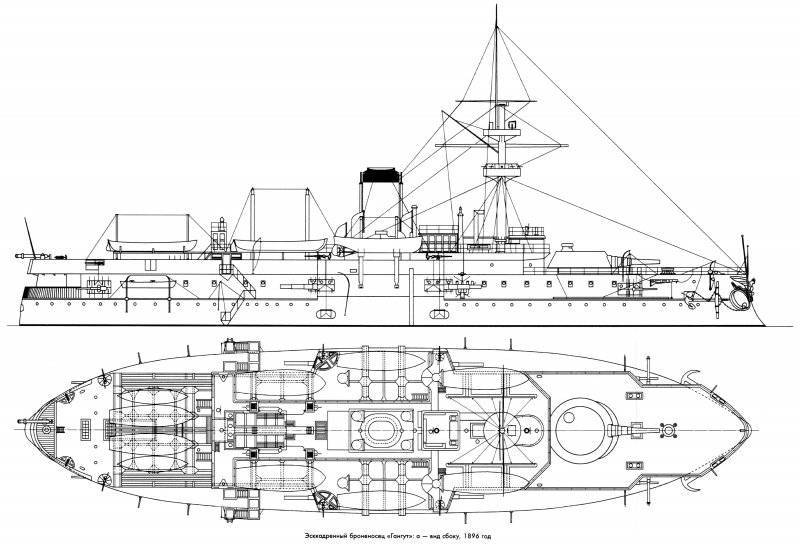
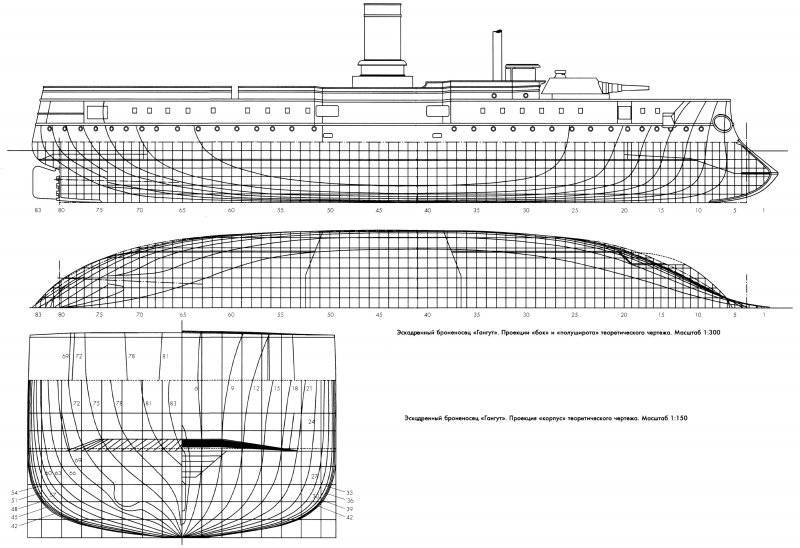
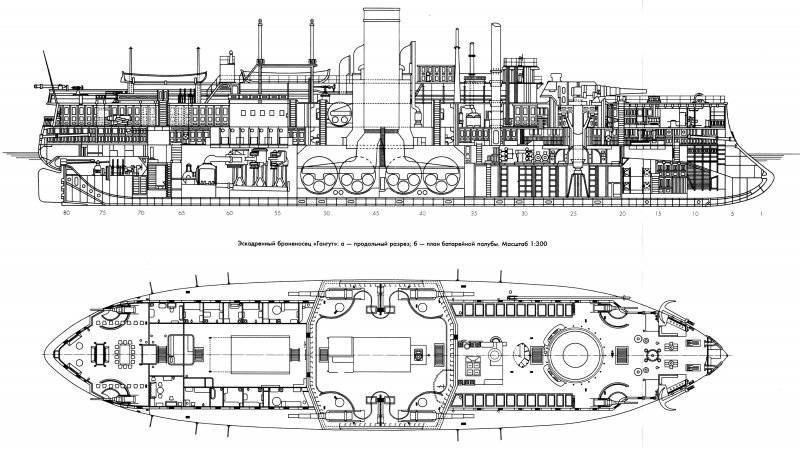
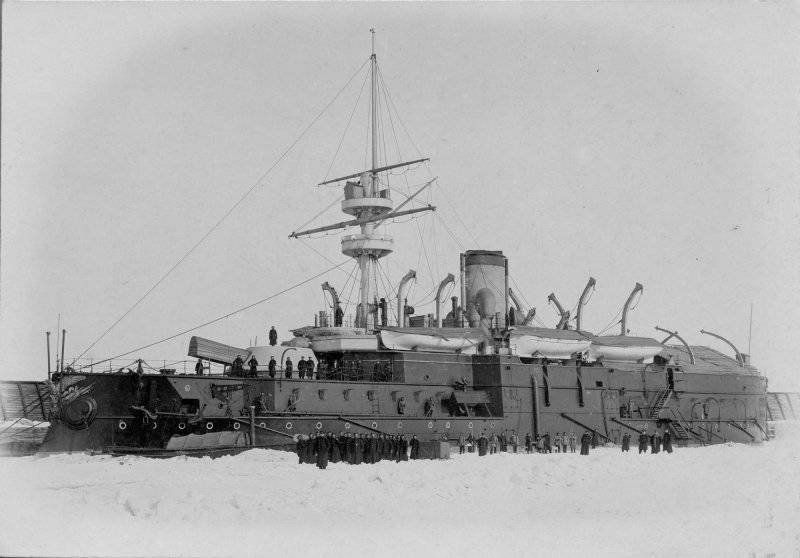
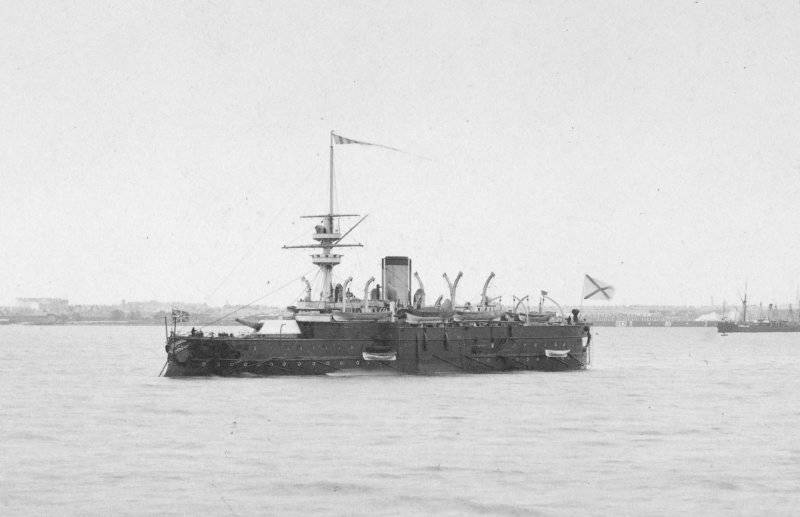
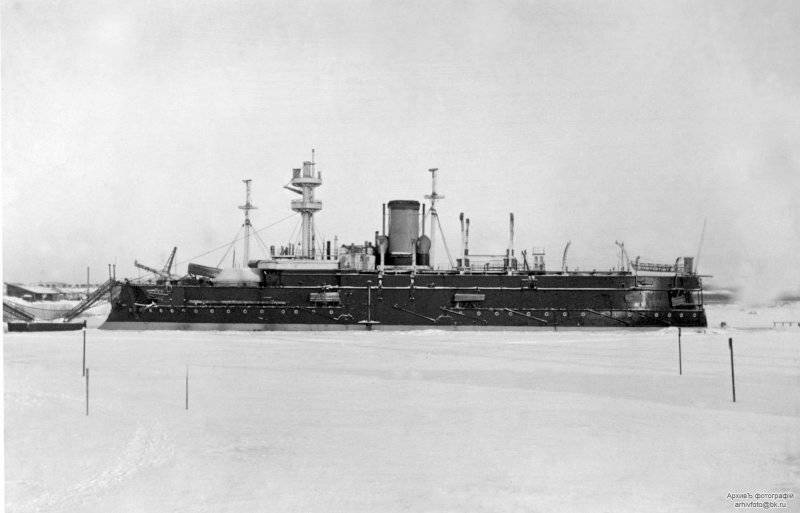
Information